This article was co-authored by Shervin Eshaghian, MD. Dr. Shervin Eshaghian is a Board Certified cardiologist and the owner of Beverly Hills Cardiology based in the Los Angeles, California metro area. Dr. Eshaghian has over 13 years of cardiology experience, including serving on the medical staff at Cedars-Sinai Medical Center. He holds a BS in Psycho-Biology from the University of California, Los Angeles (UCLA) and an MD from the Albert Einstein College of Medicine. Furthermore, Dr. Eshaghian completed an internship, residency, and fellowship at Cedars Sinai Medical Center, where he was awarded the Leo Rigler Outstanding Academic Achievement Award and the Elliot Corday Fellow of the Year Award.
There are 20 references cited in this article, which can be found at the bottom of the page.
wikiHow marks an article as reader-approved once it receives enough positive feedback. This article received 19 testimonials and 93% of readers who voted found it helpful, earning it our reader-approved status.
This article has been viewed 250,371 times.
An angiogram or angioplasty uses a long, hollow tube called a catheter to diagnose and sometimes treat problems of the heart and coronary blood vessels and arteries. This procedure can be performed during a diagnostic cardiac catheterization when a blockage is identified, or it may be scheduled after a catheterization has confirmed the presence of coronary artery disease.[1] [2] Having an angiogram may be frightening, especially if it is an emergency procedure to detect a blockage. But an angiogram is a routine procedure that is usually safe and painless. If your doctor has decided to perform an angiogram, it may be necessary to save your life. After the angiogram, there are several things that you can do to make sure that you recover well. Some of the things you can do include resting, taking your medications, and caring for your wound. Keep reading to learn more about how to recover from an angiogram.
Steps
Recovering in the Hospital
-
1Understand the procedure. During an angiogram, a doctor injects a dye into a catheter that is inserted into one of the arteries leading to your heart, lungs, brain, arms, legs, or kidneys.[3] This procedure helps doctors determine how well the blood is flowing to a certain area and it may also help them to detect potentially life-threatening blockages.
- Your doctor may use a local or general anesthetic to perform an angiogram
- The procedure takes between 30 minutes and two hours.
- You may be able to return home soon after the procedure, as long as no blockages are detected.
- The procedure is safe and usually painless, but you might have some bruising around the area where the catheter was inserted.[4]
-
2Rest after the procedure. After your angiogram is over, you will have to stay in the hospital for several hours or possibly overnight. While you are in the hospital, your will be instructed to rest. Resting is important because too much movement may cause bleeding from where the catheter was inserted. Nurses will monitor your blood pressure and other vital signs while you recover from your angiogram.[5]
- Limit your movement as much as possible. Stay in bed until you are told you may get up and walk. Do not walk around after an angiogram until your doctor says you may.
- You will be monitored for 6 hours after your procedure.[6]
- Sometimes the catheter will be left in place and removed the following morning. If the catheter is in one of your legs, you will need to keep them elevated.[7]
Advertisement -
3Take any medications your physician prescribes. You may not need any medication if no blockage was detected. If a blockage was detected, you may need to take a blood thinner for about a year after your procedure. Make sure to follow your doctor's instructions and take your medication every day. Do not stop taking your medication without consulting your doctor first.[8]
-
4Tell your doctor immediately if you notice any unusual side effects. An angiogram is usually a safe procedure with minimal complications. If you experience any unusual side effects after having an angioplasty, you should tell your doctor or a nurse right away. Some side effects need to be treated right away to avoid a life-threatening situation. Tell your doctor or nurse right away if you notice:[9]
- Excessive bleeding from the place that the catheter was inserted. A little bit of blood after an angiogram is normal, but there may be a problem if the blood can't be stopped with a small bandage.
- Pain, swelling, or redness where the catheter was inserted. You may have a bit of pain after an angiogram, but there may be a problem if the catheter site is very painful or if you also have swelling and/or redness.[10]
-
5Wait for the results of your angiogram. After your angiogram is complete, your doctor will review your results and will share them with you the same day or soon after in a follow-up office visit.[11] Try to relax and remain patient as you wait for your results.
Recovering After Returning Home
-
1Ask a friend or family member to stay with you for your first night home. You are at the highest risk of having complications your first night home after your procedure. If you live with other people, you will not need to worry about asking someone to stay with you. If you live alone, you should ask a friend or family member to stay with you for your first night back home.[12]
-
2Rest when you return home. After you return home from the hospital, you will need to continue resting for about a week. If you also had a heart attack or other serious complication, you will need to rest even longer. Plan to take at least a few days off from work to recover from your procedure.[13]
- Avoid walking up stairs for the first couple of days after the angiogram if the catheter was inserted into your groin area.[14]
- Avoid any heavy lifting or other strenuous activities for at least 24 hours. Ask your doctor when it will be okay to resume these activities again.
- You may not be allowed to drive for up to a week after your procedure. Professional drivers may need to get medical approval before they can return to work.[15]
- Wait 24 hours before showering.[16]
-
3Drink plenty of water. Since dye is injected into your artery during an angiogram, you will need to drink plenty of water after the procedure in order to flush the dye from your system.Adults should drink between six and eight cups of water per day, but you may need more or less depending on your body weight and health.[17]
-
4Continue taking your prescribed medication. If your doctor has prescribed you a medication for a condition that was detected and/or treated during your angiogram, you should continue to take this medication after leaving the hospital. Make sure that you understand the dosage instructions and contact your doctor if you have any concerns or questions about the medication. Do not stop taking your medication without consulting your doctor first.[18]
-
5Use an ice pack on the catheter site to relieve pain and swelling. You may have some minor pain and/or swelling for the first few days after your procedure and you can use an ice pack to help relieve the pain and bring the swelling down a bit. Wrap a thin towel around an ice pack or a plastic bag filled with ice and apply the ice pack to your catheter site. Do not use the ice pack for more than 20 minutes at a time.[19]
- If the pain and/or swelling worsens or does not improve, call your doctor as soon as possible.
- Applying pressure with an ice pack may also help to control any light bleeding that you are still having. However, if your bleeding is more than light and does not seem to be slowing down, then call your doctor right away.
-
6Try taking an over-the-counter pain reliever. Ice will help with pain, but it may not completely relieve your pain. If you are still having pain at the site of your angiogram even with the use of an ice pack, then you can take an over-the-counter pain reliever, such as acetaminophen. Follow the package instructions for dosage or ask your doctor for a recommendation.[20]
-
7Follow your doctor's instructions to care for your wound. Make sure that you understand and follow your doctor's instructions for care of your wound. You may be advised to avoid showering for the first two days after your procedure. Ask your doctor if you have any concerns about how to care for your wound.[21]
-
8Call your doctor if you have any concerns about your wound. In general, you may have cause to worry if the site begins to bleed, looks infected, or shows new bruising. Contact your doctor right away if you experience any of the following symptoms:[22]
- Increased pain or discomfort around the wound
- Signs of infection, such as redness, drainage or fever
- Any changes in temperature or color of the leg or arm that was used for the procedure
- Bleeding that continues after you have applied 2-3 fingers pressure to the puncture site for 15 minutes[23]
- A "golf ball" size lump or bruise over the puncture site area
- Feeling faint, weak, lightheaded, dizzy or clammy[24]
- Any chest pain or shortness of breath
Staying Healthy After an Angiogram
-
1Talk to your doctor about appropriate lifestyle changes.[25] Depending on the reason for your angiogram, you may need to make certain lifestyle changes to get and stay healthy. Talk to your doctor about specific changes that you should make.[26] Often, people have angiograms because of coronary artery disease (CAD). If this is the reason for your angiogram, talk with your doctor about the lifestyle changes you should to make. In general, these lifestyle changes include:[27]
- Quitting smoking (if you are a smoker)
- Getting regular exercise
- Losing weight (if you are overweight)
- Reducing stress
-
2Continue taking all medications your doctor prescribes. Your doctor may prescribe blood thinners or even just recommend that you take a small dose of aspirin every day. Whatever your doctor has prescribed or recommended, make sure that you understand the dosage instructions and contact your doctor if you have any concerns or questions about the medication. Do not stop taking your medication without consulting your doctor first.[28]
-
3Consider enrolling in an outpatient cardiac rehabilitation program. These can help you learn how to develop an exercise program, follow a heart healthy diet, reduce stress, and even help you to quit smoking. Your insurance will most likely cover the cost of a cardiac rehab program.[29] [30] Ask your doctor for recommendations on a cardiac rehab program in your area.
Expert Q&A
-
QuestionHow do I recover from an angiogram?
 Chris M. Matsko, MDDr. Chris M. Matsko is a retired physician based in Pittsburgh, Pennsylvania. With over 25 years of medical research experience, Dr. Matsko was awarded the Pittsburgh Cornell University Leadership Award for Excellence. He holds a BS in Nutritional Science from Cornell University and an MD from the Temple University School of Medicine in 2007. Dr. Matsko earned a Research Writing Certification from the American Medical Writers Association (AMWA) in 2016 and a Medical Writing & Editing Certification from the University of Chicago in 2017.
Chris M. Matsko, MDDr. Chris M. Matsko is a retired physician based in Pittsburgh, Pennsylvania. With over 25 years of medical research experience, Dr. Matsko was awarded the Pittsburgh Cornell University Leadership Award for Excellence. He holds a BS in Nutritional Science from Cornell University and an MD from the Temple University School of Medicine in 2007. Dr. Matsko earned a Research Writing Certification from the American Medical Writers Association (AMWA) in 2016 and a Medical Writing & Editing Certification from the University of Chicago in 2017.
Family Medicine Physician You will want to take it slow. You may have to stay overnight in the hospital and be monitored for a day. Minimize physical activity, and you want to make sure that you take your medications as prescribed.
You will want to take it slow. You may have to stay overnight in the hospital and be monitored for a day. Minimize physical activity, and you want to make sure that you take your medications as prescribed. -
QuestionHow soon after an angiogram with two stents can I resume bowling?
 Chris M. Matsko, MDDr. Chris M. Matsko is a retired physician based in Pittsburgh, Pennsylvania. With over 25 years of medical research experience, Dr. Matsko was awarded the Pittsburgh Cornell University Leadership Award for Excellence. He holds a BS in Nutritional Science from Cornell University and an MD from the Temple University School of Medicine in 2007. Dr. Matsko earned a Research Writing Certification from the American Medical Writers Association (AMWA) in 2016 and a Medical Writing & Editing Certification from the University of Chicago in 2017.
Chris M. Matsko, MDDr. Chris M. Matsko is a retired physician based in Pittsburgh, Pennsylvania. With over 25 years of medical research experience, Dr. Matsko was awarded the Pittsburgh Cornell University Leadership Award for Excellence. He holds a BS in Nutritional Science from Cornell University and an MD from the Temple University School of Medicine in 2007. Dr. Matsko earned a Research Writing Certification from the American Medical Writers Association (AMWA) in 2016 and a Medical Writing & Editing Certification from the University of Chicago in 2017.
Family Medicine Physician I would wait a week or two until to resume physical activity. The catheter site is very sensitive and can bleed if not properly taken care of. If you had the the catheter through the IVC, make sure that you keep pressure on the site to prevent bleeding. Talk with you doctor about returning to bowling as they feel appropriate.
I would wait a week or two until to resume physical activity. The catheter site is very sensitive and can bleed if not properly taken care of. If you had the the catheter through the IVC, make sure that you keep pressure on the site to prevent bleeding. Talk with you doctor about returning to bowling as they feel appropriate.
Warnings
- If you experience shortness of breath, chest pain, trouble breathing, loss of consciousness, or if you begin coughing up blood, call 911 or go to an emergency room immediately.[31]⧼thumbs_response⧽
- Call 911 immediately if you have symptoms of a heart attack. Symptoms of a heart attack include chest pain, sweating, shortness of breath, nausea, vomiting pain (in the jaw, neck, back, shoulders, arms, or upper stomach), weakness, light headedness, or a fast/irregular heartbeat.[32]⧼thumbs_response⧽
References
- ↑ http://www.vascularweb.org/vascularhealth/pages/angiogram.aspx
- ↑ https://www.nhlbi.nih.gov/health/health-topics/topics/cad/
- ↑ Shervin Eshaghian, MD. Board Certified Cardiologist. Expert Interview. 26 June 2020.
- ↑ http://www.nhs.uk/Conditions/Angiography/Pages/Introduction.aspx
- ↑ hhttps://www.heart.org/-/media/files/health-topics/answers-by-heart/what-is-a-coronary-angiogram.pdf
- ↑ http://www.vascularweb.org/vascularhealth/pages/angiogram.aspx
- ↑ http://www.nhs.uk/Conditions/Coronary-angioplasty/Pages/Recovery.aspx
- ↑ https://www.heart.org/-/media/files/health-topics/answers-by-heart/what-is-a-coronary-angiogram.pdf
- ↑ https://www.uofmhealth.org/conditions-treatments/radiology-and-imaging/patient-resources/patient-instructions/angiogram-test-prep
- ↑ https://mayfieldclinic.com/pe-angio.htm
- ↑ http://www.cpmc.org/learning/documents/ir-arteriohome-ws.html
- ↑ http://www.nhs.uk/Conditions/CoronaryAngiography/Pages/Afterwardspage.aspx
- ↑ https://www.uofmhealth.org/conditions-treatments/radiology-and-imaging/patient-resources/patient-instructions/angiogram-test-prep
- ↑ https://myhealth.alberta.ca/health/aftercareinformation/pages/conditions.aspx?hwid=zc2259
- ↑ https://www.ouh.nhs.uk/patient-guide/leaflets/files/44280Ppci.pdf
- ↑ http://www.cpmc.org/learning/documents/ir-arteriohome-ws.html
- ↑ https://www.uofmhealth.org/conditions-treatments/radiology-and-imaging/patient-resources/patient-instructions/angiogram-test-prep
- ↑ http://www.nhlbi.nih.gov/health/health-topics/topics/stents/after
- ↑ https://myhealth.alberta.ca/health/aftercareinformation/pages/conditions.aspx?hwid=zc2259
- ↑ http://www.mayoclinic.org/tests-procedures/carotid-angioplasty/basics/what-you-can-expect/prc-20005580
- ↑ https://mayfieldclinic.com/pe-angio.htm
- ↑ http://www.mayoclinic.org/tests-procedures/coronary-angiogram/basics/what-you-can-expect/prc-20014391
- ↑ http://www.cpmc.org/learning/documents/ir-arteriohome-ws.html
- ↑ http://www.cpmc.org/learning/documents/ir-arteriohome-ws.html
- ↑ Shervin Eshaghian, MD. Board Certified Cardiologist. Expert Interview. 26 June 2020.
- ↑ http://www.med.umich.edu/cardiac-surgery/patient/adult/adultcandt/coronary_angioplasty.shtml
- ↑ http://her.oxfordjournals.org/content/17/5/606.full
- ↑ http://www.nhlbi.nih.gov/health/health-topics/topics/stents/after
- ↑ http://my.clevelandclinic.org/services/heart/home-recovery/interventional-procedures/after-your-interventional-procedure
- ↑ http://www.heart.org/HEARTORG/Conditions/More/CardiacRehab/Cardiac-Rehab_UCM_002079_SubHomePage.jsp
- ↑ https://myhealth.alberta.ca/health/aftercareinformation/pages/conditions.aspx?hwid=zc2259
- ↑ https://myhealth.alberta.ca/health/aftercareinformation/pages/conditions.aspx?hwid=zc2259
About This Article
To recover from an angiogram, ask a friend or family member to stay with you the first night after the procedure if you live alone since that's when you have the highest risk of experiencing complications. Plan on taking at least a few days off of work so you can rest as much as possible. For the first 24 hours, avoid showering and doing any strenuous activities. You should also avoid walking up stairs for the first couple of days if the catheter used for your procedure was inserted into your groin area. Additionally, make sure you drink plenty of water, and take any medication your doctor prescribed you. If you experience pain and swelling during your recovery, apply an ice pack to the area for 20 minutes at a time. You can also take over-the-counter pain relievers. For advice from our Medical co-author, like how to stay healthy after an angiogram, scroll down.
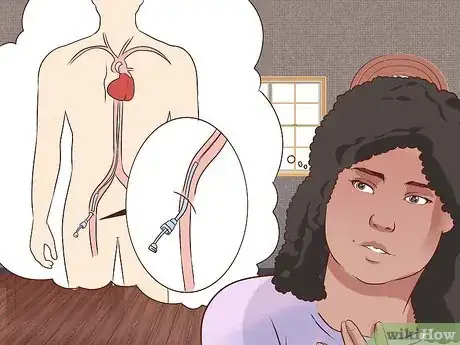


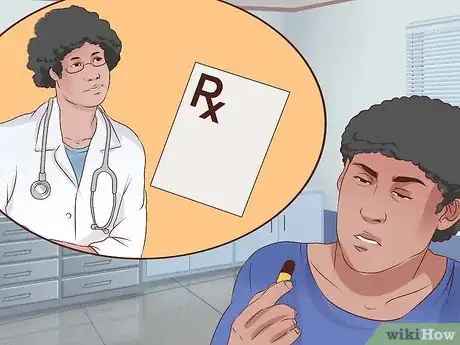
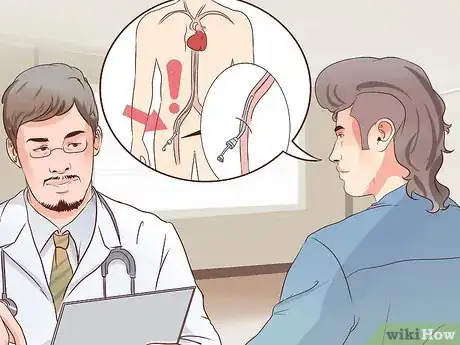
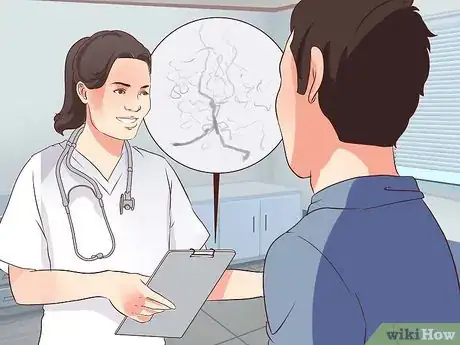




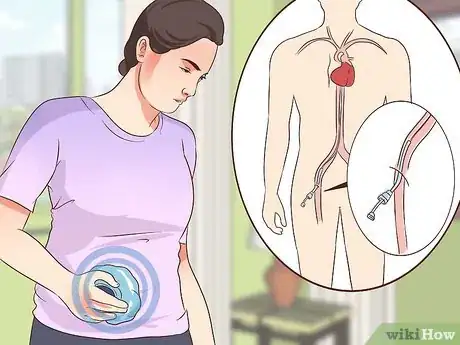

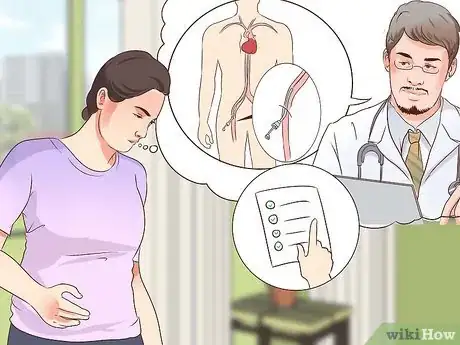
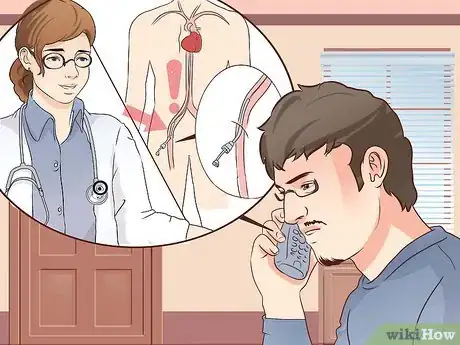
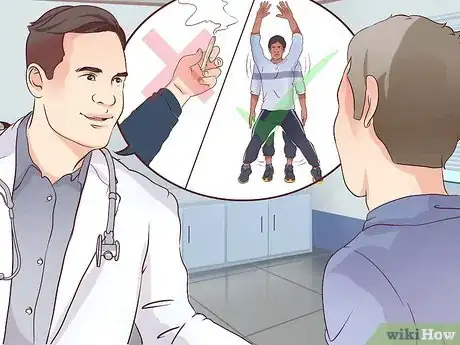
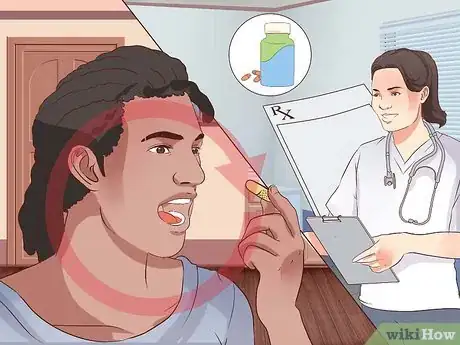










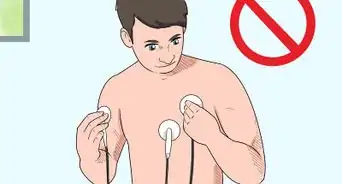
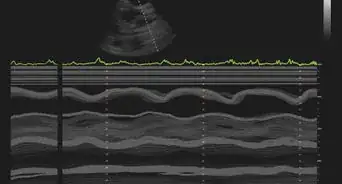


















































Medical Disclaimer
The content of this article is not intended to be a substitute for professional medical advice, examination, diagnosis, or treatment. You should always contact your doctor or other qualified healthcare professional before starting, changing, or stopping any kind of health treatment.
Read More...